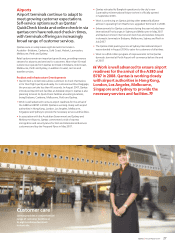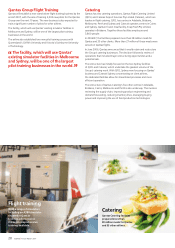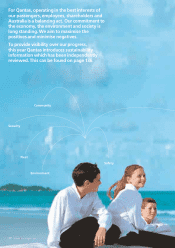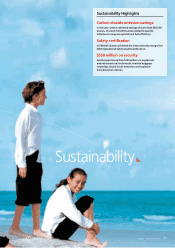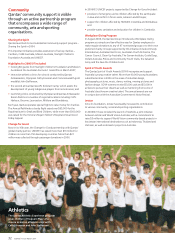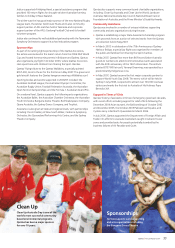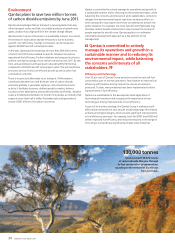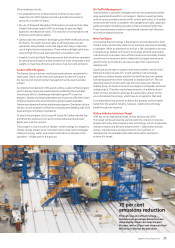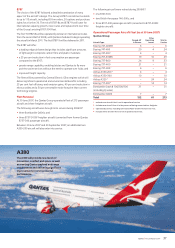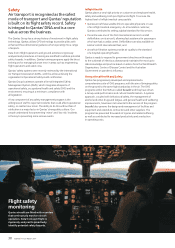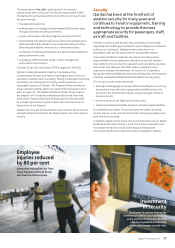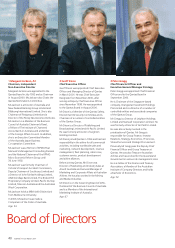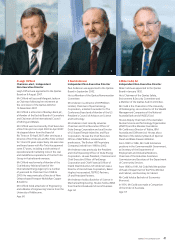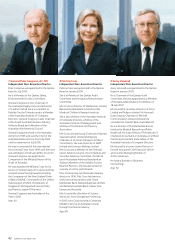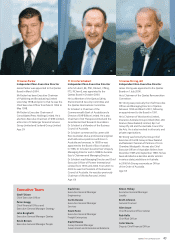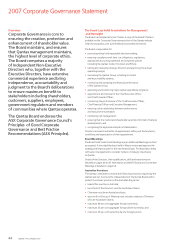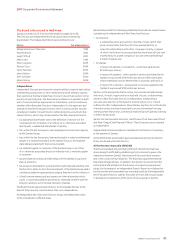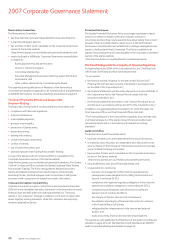Qantas 2007 Annual Report Download - page 38
Download and view the complete annual report
Please find page 38 of the 2007 Qantas annual report below. You can navigate through the pages in the report by either clicking on the pages listed below, or by using the keyword search tool below to find specific information within the annual report.
Fleet
The technological advancement
associated with the design of new aircraft
like the A380 and B787 has helped airlines
like Qantas deliver world class products.
Fleet Strategy
Qantas has always selected its aircraft from the most technologically
advanced models available, taking into consideration key factors such
as safety, passenger comfort, cost, and fuel consumption and
matching them to customer requirements and network demands.
Environmental performance, including fuel and noise emissions,
has also become a key consideration in the Group’s fleet strategy.
Qantas spends around $2 billion each year on new aircraft and
currently has on order aircraft worth around $25 billion (at list prices).
More than 100 new aircraft are scheduled for delivery from late 2007.
The next generation A380 and B787 being delivered from 2007/08
remain central to the future of the Group’s flying businesses. Both
types, including the variants of the B787, were carefully assessed to
ensure they matched the specific performance, market and route
requirements of both Qantas and Jetstar.
They will provide step change improvements in terms of fuel efficiency
compared to currently available aircraft of similar size.
Fleet Milestones
A number of strategic fleet acquisition decisions were made during
the year.
In October 2006, Qantas announced it intended to acquire
eight additional A380s, six additional A330-200s for delivery from
December 2007 and five additional B737-800s for delivery from
February 2008.
In January 2007, QantasLink announced the purchase of two
additional Bombardier Q400 aircraft to be delivered in January 2008,
boosting the Group’s Q400 fleet from seven to nine. On sectors such
as Sydney to Canberra, the Q400 delivers 30 per cent fuel efficiency
gains and emission reductions per passenger compared to regional jet
aircraft of similar size.
In March 2007, Qantas announced it would acquire nine additional
A320 aircraft for delivery over a 15-month period from late 2007,
enabling Jetstar to grow on popular leisure routes such as Cairns, the
Gold Coast, Perth and the Northern Territory and look at
new destinations within Australia.
In a further boost to Group domestic capacity, four Qantas B767-300
international aircraft are being transferred to domestic operations.
QantasLink also announced in March 2007 the expansion of its
B717-200 fleet from eight to 11 aircraft for operation on regional
routes in Western Australia, the Northern Territory and North
Queensland from August 2007.
In July 2007, Qantas announced that it would increase its B787
commitment by 20 to 65 firm orders for delivery from July 2008.
A380
Qantas will take delivery of its 20 A380 aircraft between August 2008
and 2013.
As well as providing vital capacity into constrained airports such as
Los Angeles and London, the world’s biggest passenger aircraft will
showcase the future of Qantas’ long-haul flying, with new First,
Business, Premium Economy and Economy cabins. Marc Newson
has been involved in every detail of the Qantas A380’s cabin design
with the focus on personal space and contemporary style.
The A380 will offer:
•advanced materials and aerodynamics;
•the most spacious cabins;
•a 10–12 per cent reduction in fuel consumption per passenger
compared to the B747; and
•a substantially decreased noise footprint.
Following the A380’s highly successful visit to Australia in November
2005 as part of Qantas’ 75th anniversary celebrations, the airline
worked closely with Airbus to bring the A380 to Sydney again in June
2007, where it operated the first passenger flight of the aircraft in
Australia. This followed the A380’s maiden visit to the United States
in March 2007.
36 Qantas |Annual Report 2007
Renewing the fleet
The Qantas Group has more than
100 new aircraft currently on order,
with a value of more than $25 billion.
World class
Qantas Engineering’s world class
facilities include the Rolls
Royce Centre of Excellence, which
provides Qantas with a specialised
facility for the maintenance of its
Rolls Royce engines.



